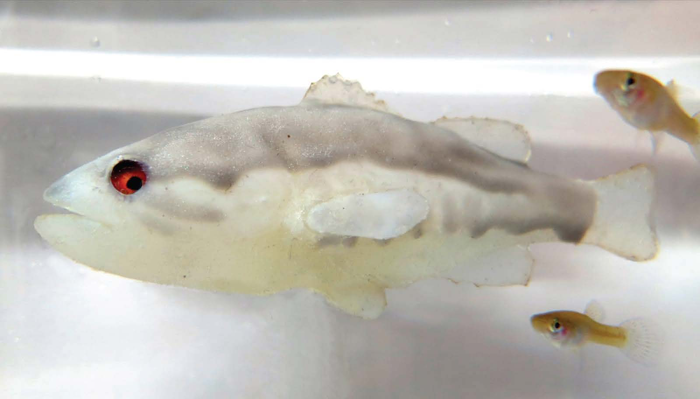:focal(350x200:351x201)/https://tf-cmsv2-smithsonianmag-media.s3.amazonaws.com/filer_public/a4/69/a46910f0-d9bb-4e6a-8104-fcedaf8b2a4c/1217_robofish.png)
Giovanni Polverino
Mosquitofish may look small and unassuming, but don’t let appearances fool you: these invasive fish are menaces. Outside of their range, they outcompete other freshwater critters—like fishes and tadpoles—and feast on their eggs. Since they don’t have any natural predators beyond their range, their population goes unchecked as they wreak havoc on native wildlife, Charlotte Hu reports for Popular Science.
For decades, scientists scratched their heads trying to figure out how to control mosquitofish in a way that doesn’t also harm the ecosystem—a seemingly impossible feat. But they’ve finally had a breakthrough with a terrifying new tool meant to intimidate mosquitofish: a robotic fish, Livia Albeck-Ripka reports for the New York Times. The researchers reported their findings this week in the journal iScience.
“Instead of killing them one by one, we’re presenting an approach that can inform better strategies to control this global pest,” lead author Giovanni Polverino, a biologist at the University of Western Australia, says in a press release. “We made their worst nightmare become real: a robot that scares the mosquitofish but not the other animals around it.”
In the 1900s, scientists introduced mosquitofish all over the world in an effort to control mosquito populations, since they feed on the insects’ larvae. The goal was to curb the spread of illnesses like malaria, but instead of feasting on mosquito larvae, the fish chomped on native critters and their eggs. Without a natural predators around, the population boomed, Jonathan Lambert reports for Science News.
The robot—shaped like a largemouth bass, one of the mosquitofish’s natural predators—was equipped with a camera to differentiate between mosquitofish and tadpoles. The researchers set up 12 tanks with six mosquitofish and six tadpoles in each one and allowed the critters to acclimate for a week before meeting the robot. For one hour twice a week for five weeks, each group was placed in a tank with the robot, Science News reports.
In the robofish’s presence, the mosquitofish spent more time clustered together, and their swimming became more erratic, which was good news for the tadpoles. With the mosquitofish anxious and scared, the tadpoles ventured out more without fearing that the fish would nip at their tails. These effects even lasted for weeks after the final encounter with the robot. When the critters returned to their tanks, the mosquitofish were less active and didn’t eat as much, which are signs of anxiety, according to the press release.
The mosquitofish spent so much energy living in terror that they cashed in their energy reserves, causing them to lose weight. Males’ body shapes also changed to become more streamlined, likely so they can escape more quickly when they’re scared. Lastly, their sperm count dropped by about 50 percent, Science News reports.
“You don’t need to kill them,” Polverino tells the Times. “We can basically inject fear into the system, and the fear kills them slowly.”
Though the study showed promising results, these robots can’t be released into the water yet. The team still needs to understand the long-term impacts on other wildlife and downstream effects on the ecosystem as a whole. But Polverino says they achieved their main goal: to prove that fear can affect the survival and reproduction of mosquitofish, Science News reports.
“Hopefully, our approach of using robotics to reveal the weaknesses of an incredibly successful pest will open the door to improve our biocontrol practices and combat invasive species,” Polverino says in the press release. “We are very excited about this.”
For their next steps, the team will test the robot in freshwater pools in Australia, where mosquitofish threaten multiple endangered species, the Times reports.
Recommended Videos
Credit: Source link





















